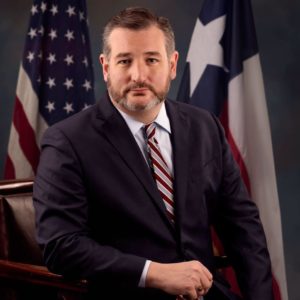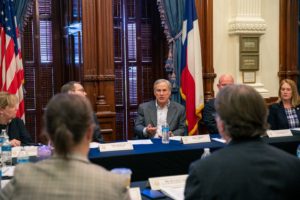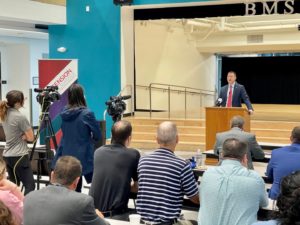High school football coach who prayed at midfield gets warm reception from some justices
(SCOTUSblog) – During…
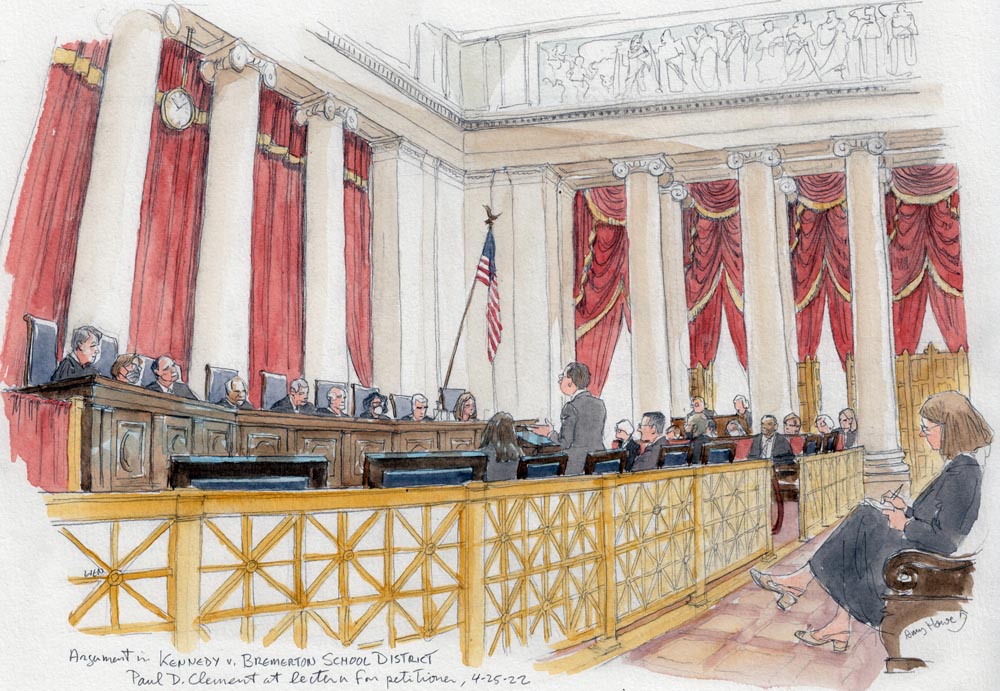

Paul Clement argues on behalf of former high school football coach Joseph Kennedy. (Art Lien)
(SCOTUSblog) – During nearly two hours of oral argument on Monday, a majority of the Supreme Court appeared sympathetic to a high school football coach who sued his school district after he lost his job because of his post-game prayers at the 50-yard line. It was unclear, though, what rationale the justices might adopt if they ultimately rule in the coach’s favor.
That’s because the case, Kennedy v. Bremerton School District, tests the boundaries of three First Amendment rights that at times overlap or are in tension. And the already thorny case is made even more complicated by the fact that, as Justice Stephen Breyer noted, the coach and the school district have very different views not only of the legal issues in the case, but also of the facts.
Representing coach Joseph Kennedy, lawyer Paul Clement told the justices that when Kennedy kneeled at midfield to give a brief prayer of thanks shortly after each game, his expression was entirely his own and was doubly protected by the First Amendment under the free speech and free exercise clauses. The school district, Clement added, has confirmed that the sole motivation behind its actions against Kennedy was to avoid violating the establishment clause by endorsing Kennedy’s prayers. But the government does not endorse all private religious speech just because that speech happens to occur at school, Clement stressed.
Justice Clarence Thomas appeared sympathetic. During a series of questions for Clement about the Supreme Court’s decision in Garcetti v. Ceballos, which held that the First Amendment does not protect speech by government employees as part of their official duties, Thomas told Clement that “we know” that the post-game prayer “is not part of his job.” The school district was not aware of Kennedy’s post-game prayers until a coach from another school mentioned them to the Bremerton High School principal, Thomas noted, and once it knew about the prayers it objected to them. (That’s “music to my ears,” Clement responded.)
Other justices sought to probe the distinction between government and private speech by teachers and coaches. Justice Sonia Sotomayor peppered Clement with hypothetical situations, asking him to weigh in on whether religious speech fell within a teacher’s official duties or instead was private speech. Clement allowed that if a teacher began a class with an audible prayer, that would fall within her official duties, while reading the Bible before the bell rings would not.
Sotomayor then asked whether an employee could be fired for texting her husband during school hours if that violated school rules. Why, Sotomayor queried, can’t an employer tell an employee what they are allowed to do? In this case, she noted, there are a “dozen or more statements” from Kennedy acknowledging that his duties extended past the end of the game – and he was fired for not fulfilling them.
Chief Justice John Roberts chimed in, asking Clement about a scenario in which a hypothetical coach’s activity was more “extensive,” as Roberts characterized it: A coach is praying out loud while standing up, with his arms outstretched.
Clement responded that the school district can determine what the coach’s duties are. And in Kennedy’s case, he reiterated, it is undisputed that coaches could do other things for 15 to 20 seconds.
Justice Elena Kagan suggested that the focus on whether Kennedy’s prayers were “government speech” was misplaced. What the justices should really be worried about, she said, is pressure on students to participate in religious activities when they don’t want to.
Clement countered that the lower courts’ rulings had rested on the premise that the school district wanted to avoid being seen as endorsing religion, rather than concerns about coercion.
Kagan pushed back, outlining a scenario in which the school district had properly asserted that it wanted to ensure that students did not feel coerced to join the prayers because their playing time might hinge on it, which would be “improper for 16-year-olds.”
Clement conceded that concerns about coercion “may well be well placed” if the coach were giving the prayer as part of a post-game talk, but he suggested that they would not be raised by a “15-second fleeting prayer” alone at midfield.
And when Kagan suggested a variation on those hypotheticals, in which a coach who had been asked to stop including a prayer in his post-game talk decided to delay the start of the talk and fill the gap with a prayer, Clement again acknowledged that there “may well be a coercion concern,” but he added that a 15-second prayer at midfield, while most of the players are still in the end zone, would not be “coercion that counts under the establishment clause.”
Clement’s response prompted Kagan to ask whether the main question in the case before the justices is what the correct version of the facts is. Clement answered that it is “one of the questions in this case,” and he stressed that it is an important question because, “if you don’t distinguish between the two situations, then you’re leaving teachers and coaches in a position where there’s no material room for their free exercise of religion or their free speech” – contrary to the Supreme Court’s longstanding case law.
Arguing for the school district, lawyer Richard Katskee told the justices that the problem was not Kennedy’s quiet prayer by himself. Instead, Katskee explained, the issue was that Kennedy “insisted on audible prayers at the 50-yard line with students,” because he believed that the prayers “are how he helps these kids be better people.” Kennedy’s actions, Katskee continued, put pressure on players to join the prayers, “divided the coaching staff, sparked vitriol against school officials, and led to the field being stormed and students getting knocked down.”
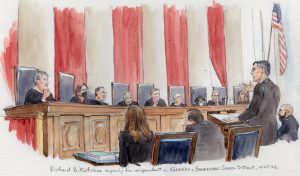
Richard Katskee argues on behalf of the Bremerton School District. (Art Lien)
Justice Samuel Alito was dubious about whether all of the facts that Katskee cited mattered to the court’s analysis. He acknowledged that the case was complicated, but for him it boiled down to an employment discrimination case. And in such cases, he told Katskee, courts look at the reasoning – here, the school district’s professed desire to avoid violating the establishment clause – behind the employer’s actions. If the employer’s actions were unlawful (and Alito seemed to suggest that the school district’s conduct had been), he explained, then the employee wins.
Katskee reminded Alito of the “enormous pile of evidence that the school district acted on other concerns” when it suspended Kennedy – for example, it was worried about student safety and the possibility that spectators would storm the field.
Alito was unconvinced, asking somewhat incredulously whether the school district is arguing that if an employer gives an unlawful reason, it can still prevail because it could have given legal reasons for its conduct.
Justice Brett Kavanaugh also appeared skeptical. The school district’s “sole reason” for taking action against Kennedy, he noted, was to avoid violating the establishment clause by endorsing religion. But the Supreme Court had not applied the Lemon test – the three-part test, named after the court’s 1971 decision in Lemon v. Kurtzman, for establishment clause cases – “in two decades,” Kavanaugh observed. And Kennedy’s case seems to go beyond Santa Fe Independent School District v. Doe, the court’s 2000 decision holding that student-led, student-initiated prayer over a loudspeaker at football games violates the establishment clause, Kavanaugh told Katskee. “I don’t see why the Court shouldn’t say,” Kavanaugh said later, that it won’t extend Santa Fee beyond prayers in the locker rooms or huddles.
Justice Neil Gorsuch also raised questions about the school district’s reliance on the Lemon test. What should the justices do, he asked Katskee, if they believe the school district and the courts below should have focused on concerns about coercion, rather than endorsing religion?
Katskee urged the court to send the case back to the lower court for another look, stressing the availability of other evidence “of all the other reasons that the district acted and expressions either to Mr. Kennedy or to the community of concerns.”
But Clement implored the justices not to send the case back to the 9th Circuit for it to apply a coercion test. “There’s no evidence of coercion contemporaneously,” Clement emphasized. But more broadly, Clement continued, Kennedy “has already waited six years to get his job back.” When both of the lower courts have already agreed with Kennedy that the school district took action against him only out of a desire to avoid endorsing religion, “that is not something that should stand.”
This article was originally published at Howe on the Court.

